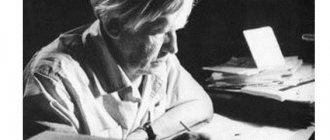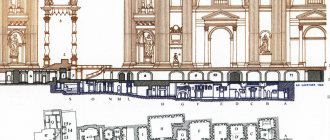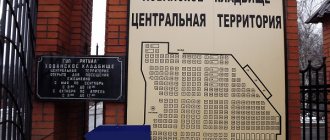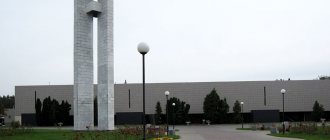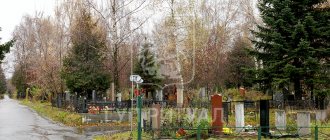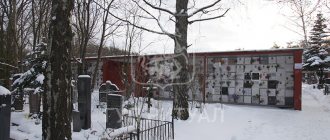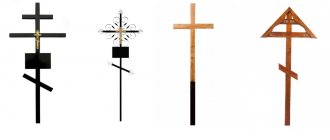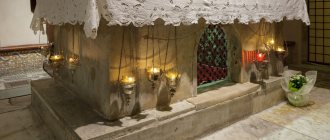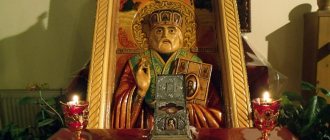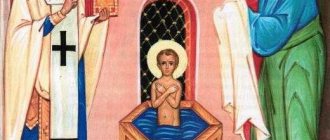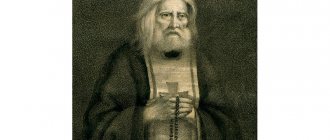The Vagankovskoe cemetery is one of the most famous burial grounds in Russia. It is here that famous actors, athletes, poets and public figures find their final refuge. For the same reason, “Vagankovo,” as the necropolis is popularly called, is also considered the most visited cemetery in Moscow.
Is it any wonder that the cost of a plot here is comparable to the price of a one-room or even two-room apartment in the capital. One of the Russian news publications wrote about this in 2022. On the official website of the graveyard, its type is completely defined as “closed for free burials.” This means that it is now impossible to buy plots for family burial - they are not put up for auction.
Temple and grave of Abdulov. A little closer to the church is the grave of Mashenka Shilova, © Church of the Resurrection of the Word on VKontakte
History of the Vagankovskoe cemetery
But the necropolis was not always prestigious, so to speak. In the first years of its foundation, those who died of the plague in 1771 were buried here. This is according to official data. According to unofficial sources, the cemetery was founded back in 1696.
The cholera epidemic that broke out in 1830 also claimed many lives. Those affected by the deadly disease were buried in the area that later became part of the cemetery.
After 18 years, the land plots were divided into categories: the first was more expensive, and the last, also the seventh, was completely free. Here, by the way, the last refuge of the victims of the Khodynka disaster in 1896 was found.
By this time, the necropolis had grown to 38 hectares. And in 1917 its area was 50 hectares , which is comparable to its current size. At the same time, the cemetery began to gradually turn into a traditional burial place for the creative intelligentsia.
As for the name, its origin is associated with the village of Vagankovo, on whose territory the necropolis was located. The etymology of the word is explained by several versions: from the Vologda “vaganit” - “to indulge”, settlements near the Northern Dvina - vogan or vozhan and vagannoy - monetary tax.
© Church of the Resurrection of the Word on VKontakte
origin of name
There is no clear version about the origin of the name. There are several of them. The most common hypothesis is related to the word “vaganit”, which, according to Dahl’s dictionary, means: to make laugh, joke, play around. Since “amusing people” lived in Vagankovo, this version is completely justified. Historians associate the name with the collection of a monetary duty for weighing goods on scales (wags).
It is assumed that at this place there was an intersection of important trade roads and a ford across the Moscow River. Nearby there was a customs outpost called “Vaganets”, and the tax itself was called “Vaganny”. According to another version, the name comes from the word “vagan”, which was used to describe simple “uncouth” men.
Who is buried at the Vagankovskoye cemetery
Over the entire period, half a million people were buried here. But only a fifth of the graves have survived to this day. For more convenient orientation, the territory was divided into 60 sections of different sizes.
Some paths and alleys bear the names of deceased celebrities: Yeseninskaya, Surikovskaya, Prokhorovskaya, Verstovsky and others.
In the churchyard you can see both abandoned graves overgrown with grass and those buried in flowers. The burial place of revolutionary Anatoly Zheleznyakov looks unkempt . Although the words engraved on the monument promise something completely different - national memory and love. The area near the grave of the Bolshevik leader Ernest Bauman .
It is much easier to find the burial place of Vladimir Vysotsky - it is located in the most prominent and honorable place. In the central row lie the remains of famous coaches and football players, including goalkeeper Lev Yashin . They say that such an elite place was chosen for a reason: the former director of the cemetery sympathized with football and the players.
The most popular graves also include the graves of the poet Sergei Yesenin , pantomime Leonid Engibarov , journalist Vlad Listyev , actors Oleg Dal , Andrei Mironov , young Nord-Ost actors Arseny Kurylenko and Kristina Kurbatova , who died during the seizure of the Moscow theater in 2002.
There is almost always a crowd at the monument to the Russian church saint Father Valentin Amfitheatrov . The famous priest was revered during his lifetime and was even called the Moscow John of Kronstadt. Believers still come to him for help.
Next to the remains of the confessor stands a memorial in honor of the soldiers who died for Moscow . Another mass grave is located on Timiryazevskaya Alley of the Vagankovsky cemetery. Workers-combatants who fought against the tsarist troops in 1905 rested there.
Map of Vagankovo sections on the official website
1 of 7
Vysotsky’s grave Photo: © Church of the Resurrection of the Word on VKontakte
All the secrets of the wonderful grave of Father Amfitheatrov
There is a place at the Vagankovskoye cemetery that is crowded in any weather. In plot No. 21, where the military grave is located, lie the remains of Father Valentin (Amphiteatrov), one of the most mysterious persons in the history of the country and the church. Believers consider him a saint whom anyone can ask for anything. .
Graves of Father Valentin
Father Valentin (Amphitheaters), whom people simply call Father, lived at the end of the 19th century, served in a Moscow church and was an extraordinary, sympathetic person. So much so that in all parts of Moscow people knew: if you really need something - advice, help or a kind word, go to Father Valentin.
They say that when pilgrims from the Mother See came to John of Kronstadt, he sent them back: “You have Father Valentin in Moscow, contact him.” According to legend, shortly before his death, the priest left a prediction: he will hear everyone who comes to his grave and asks for help and will fulfill the request before the person has time to leave.
This is how people have been walking for more than a hundred years. Although no one knows the exact burial place of Father Valentin. During the years of repression, the grave was razed to the ground, and later a mass grave was built on this site to stop the pilgrimage to Father Valentin. They say that the priest foresaw this and before his death asked to bury himself as deeply as possible. Although the grave that Amphitheatrov spoke about still exists. Even two. They are located on the territory of the memorial complex literally a meter from each other. Both always have queues. On one there is a white stone cross, at its foot memorial candles and lamps are burning, there are notes with requests addressed to the priest, and there are fresh flowers.
Below is a sign with the inscription “Archpriest Valentin Nikolaevich Amfitheatrov. 1836–1908". People pray and hold on to the white cross. Then they come to another grave, above which rises a wooden cross. They pray again and hold on, but this time to the fence - at the foot of the cross hangs a sign “Please do not touch the cross with your hands. Let’s save the priest’s grave together.” An elderly woman in a headscarf earnestly presses her head to the crucifix and whispers the words of prayer for a long time. Then he turns around and... again applies it to the next plate with the names of the soldiers.
“The white cross is memorable, symbolic,” said Evgenia Viktorova, the great-granddaughter of Father Valentin. She often comes to Vagankovskoye, orders a memorial service in the Church of the Resurrection of the Word and lights candles for the repose of her great-grandfather’s soul. “In 1990, my sister Lyubov Nikolaevna and I installed it with the blessing of Patriarch Pimen, so that there would be a place to pray for the priest. They placed it on the edge of the site, without affecting the war memorial. The wooden cross was erected by admirers of Father Valentin. For some reason they believe that his remains are there. This is probably not the case, but I don't mind.
Ask for what you want
Even if not in the blink of an eye, miracles happen to those who come to Father Valentin. Tatyana Nikiforova, who comes here regularly, learned about the priest only three years ago. One day he and his friend were walking through the cemetery, looking at the monuments of celebrities. We met some young guys - they asked the way to Amphiteatrov. “This is probably an artist?” – the pensioners were confused. That same evening, out of curiosity, they found the grave of Father Valentin and have been visiting her constantly since then. Tatyana Vladimirovna suddenly began to notice unusual things:
– I used to have myopia minus three, but now I go without glasses – thanks to the priest. My granddaughter was born after a caesarean section; one eye was difficult to open. I asked Father Valentin about it, my eyes began to open more. When she grows up, I’ll bring her to her father.
A young girl in a mink coat came to Vagankovskoye for the first time.
“He helped my friend find a job,” she says. “I went to Father Valentin, prayed, and immediately received a call from the company. Now she is one of the best employees there. And he helped my mother save her place. Her boss survived, she prayed to Father Valentin, and this man was transferred to another department.
The great-granddaughter of Father Evgeniy Viktorov also feels his help. She is sure that it was Father Valentin who helped her family solve their housing problem in 1970. When the priest’s two-story house in Ochakovo burned down, they stood in line for housing for a long time - the coveted warrant was issued to Evgenia Nikolaevna’s father on May 7, on the day of the priest’s angel.
“You can contact Father Valentin with any requests,” assured the servant of the Church of the Resurrection of the Word. “And it doesn’t matter what cross he lies under.” He is with us everywhere.
He gave money to the poor, accommodation for the homeless
Valentin Amfitheatrov became a legend during his lifetime. He was born into the family of a priest, and the sonorous surname of Amphitheaters is actually a priestly name, and not a bright pseudonym, as it might seem. He graduated from theological seminary, married a friend’s sister, and the couple had four children. At first, Valentin served in the Kaluga region, then in the Moscow Church of Saints Constantine and Helen, where, thanks to him, they say, it was crowded even on weekdays. He knew how to listen and console, but he did not know how to refuse and did not want to.
He found jobs for the unemployed, sent the sick to doctors he knew, who saw them for free, settled the homeless on the ground floor of his two-story house, found foster families for orphans, and married off widows. Rich parishioners gave Father Valentin money - he distributed everything to the poor. 6 years before his death, the priest became blind and could not conduct services in the temple; he received believers at home.
Amphitheaters died in 1908. People didn’t stop coming to see him – now to his grave. A tradition arose of taking sand from it, which supposedly healed diseases. They say that Matronushka herself had such sand; she greatly revered Valentin Amfitheatrov.
One of Father Valentin’s parishioners, Anna Zertsalova, introduced the custom three times a year - on Father Valentin’s birthday, the day of his angel and the day of death - to gather believers, invite priests and hold a solemn funeral service. This cost her first her housing, and then her freedom and life - 75 years ago, on November 27, 1937, Zertsalova was shot at the Butovo training ground.
In 2000, Anna Zertsalova was canonized. But this never happened to the priest himself, although the commission made the decision to canonize him 14 years ago. This does not prevent pilgrims from believing that Valentin Amfitheatrov is a saint.
- Well, who else? - Muscovite Vladimir Alekseevich, who came to ask the priest to save his son from alcoholism, is surprised. – If Valentin had not helped, would people have come here?
Route
How to get there
From the Ulitsa 1905 Goda metro station, walk along Bolshaya Dekabrskaya Street to the entrance to the Vagankovskoye Cemetery. On the central alley near the monument to Alexander Abdulov, turn left and follow the signs “Tomb of Archpriest Valentin Amfitheatrov.”
What to take with you
Flowers, sweets for the memorial (they are supposed to be left in the church, not on the graves), money to order a memorial service for the priest at the Church of the Resurrection of the Word.
Monuments and gravestones in Vagankovo
There are 259 cultural heritage sites on the territory of the necropolis. Some of them periodically suffer from the hands of vandals. Thus, unknown persons deprived the monument to the musician Maria Gorelova of bronze strings, and the grave of the artist Nikolai Romadin - an easel.
of the notorious thief Sonya the Golden Hand without a head . A few more distinctive features of the tombstone are a composition in the form of black palm trees and inscriptions like “Help me buy an apartment” and “Sonya, teach me how to live.” But their recipient rests in a completely different place - the grave is empty and, according to rumors, was built for fun.
The same cannot be said about other representatives of the criminal world . The tombstones of the Kvantrishvili brothers, thief in law Vyacheslav Ivankov (“Yaponchik”) with a whole sculptural composition in the form of a high wall, a grate and a bronze statue of the criminal authority itself are particularly pompous.
The most expensive monument in the cemetery rises above the burial place of Lydia Chernikova. It represents a reclining female figure made of white Carrara marble, covered with a plastic cap. It is not known exactly who the deceased was. According to one version, the woman worked as deputy editor-in-chief of the State Television and Radio Broadcasting Company.
But the tombstone of the great actor Georgy Vitsin , on the contrary, is distinguished by its modesty - an ordinary slab and a cross. It is said that his daughter refused to install another headstone.
They say a lot about the grave of Igor Talkov . And about the wooden cross that the bard found shortly before his death and brought home, which is considered a bad omen. And about his crazy fan who wanted to be buried nearby, but was stopped in time.
It will be difficult to pass by the monuments to Vasily Aksenov, Alexander Abdulov, Mikhail Pugovkin, Mashenka Shilova - the daughter of the famous artist Alexander Shilov, who died at the age of 16 from sarcoma.
Two-story columbarium, © acvazul-v2010
Columbarium
There are two types of columbarium on the territory. In the central part of the churchyard there is a two-story churchyard. It is also called one of the largest repositories of urns with ashes in Europe. It was erected in the late 70s of the last century on the site of church houses.
The second type of columbarium is open. It consists of free-standing walls with niches. After cremation, all urns are walled up and covered with special slabs.
Celebrity graves
The Vagankovsky necropolis is known as the burial place of famous people of Russia. The first famous burials appeared in the middle of the 19th century. Here you can see the graves:
- Decembrists, including: M.A. Bestuzheva, P.S. Bobrishcheva-Pushkina, I.N. Khotyaintseva.
- Composer A.N. Verestovsky, author of the immortal opera “Askold’s Grave”.
- Compiler of the explanatory dictionary V.I. Dahl
19th century artists found their eternal resting place:
- Outstanding portrait painter V. A. Tropinin, author of more than 3 thousand paintings, incl. famous portrait of A.S. Pushkin.
- V. I. Surikov, famous for his historical paintings: “Boyaryna Morozova”, “Morning of the Streltsy Execution”, “Suvorov’s Crossing of the Alps”.
- V.V Pukirev, who painted the immortal painting “Unequal Marriage”.
- A.K. Savrasov, author of the works “The Rooks Have Arrived” and “Barge Haulers on the Volga” and many others.
Since the 20th century, actors, directors, writers, artists, politicians and artists have traditionally been buried at Vagankovo. Many outstanding personalities found eternal rest here, including:
- Poets – S. Yesenin, V. Vysotsky, B. Okudzhava, M. Tanich
- Writers – V. Aksenov, G. Gorin, V. Dragunsky, V. Kaverin, V. Rozov
- Directors – V. Pluchek, S. Rostotsky, G. Chukhrai, A. Alov, P. Fomenko
- Actors - A. Abdulov, G. Burkov, Yu. Bogatyrev, G. Vitsin, E. Garin, V. Glagoleva, M. Gluzsky, O. Dal, M. Liepa, A. Mironov, S. Mishulin, T. Nosova, M. Pugovkin, Z. Reich (wife of S. Yesenin), N. Rumyantseva, V. Solomin, L. Sukharevskaya, Z. Fedorova, L. Filatov, M. Tsarev, G. Yumatov.
- Other famous figures are natural scientist K. Timiryazev, academician A. Speransky, journalist and TV presenter V. Listyev, singer I. Talkov, football goalkeeper L. Yashin, figure skater L. Pakhomova.
Temple at Vagankovskoye Cemetery
An Orthodox building with a long history - construction began in 1819 and lasted for 12 years.
The church project was developed by the architect Afanasy Grigoriev, who restored many Moscow buildings after the fire of 1812. The temple, built in the Empire style, was consecrated in honor of the Resurrection of the Word. This is a traditional name for cemetery churches.
In 1864, two more chapels were added to the main altar of the religious building. Together with other church buildings, the architectural ensemble of St. Andrew's Church with an almshouse and a refectory, they exist to this day.
Worship services are held every day. They are supplemented by special prayers: molebens and memorial services.
Schedule of services on the official website of the temple at the Vagankovskoye cemetery
Inside the Church of the Resurrection of the Word, © Temple of the Resurrection of the Word on VKontakte
Military and historical burials
There are many mass graves and mass graves at the Vagankovsky memorial complex. The heroes of the War of 1812, who fell in the Battle of Borodino, the defenders of Moscow in the Great Patriotic War, who did not allow the Nazis to enter the capital, who died in battles and air raids in 1941-1942, are buried here. Not far from the cemetery in May 1896, the Khodynka tragedy occurred, when almost one and a half thousand people were crushed during the distribution of souvenirs in honor of the coronation of Nicholas II. The mutilated corpses were taken to Vagankovo and piled in the meadow. Those who could be recognized were buried by relatives in coffins.
According to the publisher A. Suvorin, “all of this was inflated, black, and the stench was such that it was done badly,” so most remained unrecognized and were buried in common graves at site 6. Here is also the so-called “execution”: those buried according to the “execution lists” received by the cemetery commandant from the OGPU during the years of Stalin’s repressions from 1926 to 1936. The exact number of “enemies of the people” is not known. Burials were made secretly at night in a remote area in a ravine near a stream. Monuments have been erected to the victims of political repression and the Khodynka disaster.
Our contemporaries who died during the 1991 coup and the tragedy that occurred in October 2002 as a result of gas poisoning during the terrorist capture in the theater center on Dubrovka found eternal rest in the cemetery. The graves are located in different areas, only two young actors from the musical rest nearby.
Excursion
You can get to the territory of the necropolis on your own. There are no restrictions. The cemetery entrance is open daily.
Opening hours: from May to September - from 09:00 to 19:00, from October to April - from 09:00 to 17:00.
But if you want to learn more about your favorite idols, the history and secrets of the churchyard, sign up for a tour. This can be done either on site; a special bureau has been operating here since 2022, or you can book the service online.
Approximate duration: from 40 minutes to two hours. Cost - from 900 rubles. per person. You can save money if you take a free excursion. Such walks need to be monitored in advance.
The most expensive gravestone in the cemetery, © acvazul-v2010
